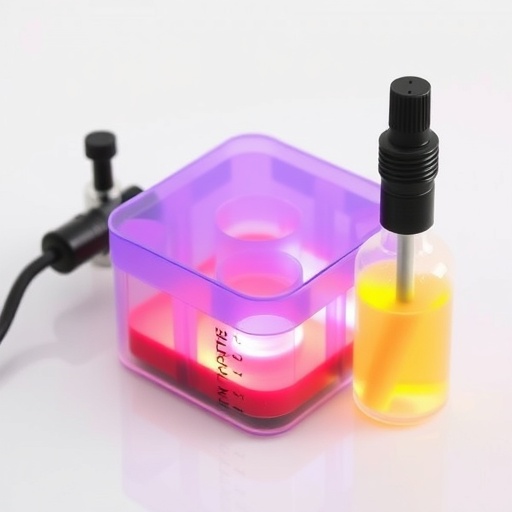In the continuously evolving field of reproductive biology, a remarkable discovery has been made regarding the role of extracellular vesicles (EVs), particularly exosomes, in the development and potential enhancement of oocyte competence. Emerging research led by Ezzati and Izadpanah highlights how these tiny membrane-bound vesicles play pivotal roles in cellular communication, facilitating the transfer of molecular information that influences oocyte quality and viability. This cutting-edge investigation could pave the way for groundbreaking applications in fertility treatments and reproductive health, significantly impacting both clinical practices and our fundamental understanding of reproductive biology.
Extracellular vesicles, especially exosomes, have garnered attention due to their involvement in various physiological processes, including cell-to-cell communication, immune responses, and the transfer of bioactive molecules such as proteins, lipids, and RNAs. These vesicles are secreted by almost all cell types and can be isolated from various biological fluids, providing a non-invasive method to study cellular states and conditions. The findings from the research by Ezzati and Izadpanah suggest that exosomes derived from ovarian cells might serve as valuable biomarkers or therapeutic agents, offering insight into oocyte quality and developmental potential.
The focus of this research centers on the connections between EVs and oocyte competence, addressing the vital question of how these vesicles could be harnessed to monitor and potentially modulate oocyte quality. It is known that oocyte competence is crucial for successful fertilization and subsequent embryo development; thus, understanding the underlying mechanisms through which exosomes influence oocyte maturity is essential for advancing fertility treatments. The authors explore the molecular content of exosomes and how their specific cargo can reflect the physiological state of their parent cells, thereby serving as indicators of oocyte health.
Moreover, the study emphasizes the significance of identifying and analyzing the specific proteins and nucleic acid profiles contained within exosomes. These molecules can reveal critical information about the regulatory pathways influencing oocyte maturation and viability. For instance, the presence of particular microRNAs or proteins linked to cell growth and apoptosis may serve as direct indicators of oocyte quality. By developing methodologies to assess exosomal content, researchers can gain deeper insights into the dynamics of oocyte development, potentially leading to innovative strategies for enhancing fertility outcomes.
As researchers delve deeper into the interaction between exosomes and oocytes, they are also examining how these vesicles may play protective roles during oocyte maturation. The ability of exosomes to transfer antioxidants and other protective factors could mitigate oxidative stress, a known detriment to oocyte health. Understanding these protective mechanisms not only sheds light on the mysteries of early embryonic development but also opens avenues for potential therapeutic interventions aimed at preserving oocyte viability in various clinical contexts.
Interestingly, the therapeutic potential of exosomes extends beyond mere monitoring. The possibility of utilizing these vesicles as delivery vehicles for drugs or genetic material highlights their versatility in medical applications. Imagine a future where exosome-based therapies could enhance oocyte quality prior to in vitro fertilization (IVF) procedures. Such approaches could revolutionize patient outcomes in assisted reproductive technologies by providing bespoke treatments tailored to individual physiological conditions.
However, while the prospects appear promising, there are substantial challenges ahead. More extensive clinical studies and trials are necessary to validate the findings from laboratory and animal models in human populations. Determining the safety and efficacy of exosome-based therapies will be crucial before they can be integrated into clinical practice. Researchers must also navigate the complexities of exosome isolation and characterization, ensuring consistency and reproducibility in their methodologies.
In summary, the groundbreaking work by Ezzati and Izadpanah represents a significant leap forward in our understanding of the importance of extracellular vesicles in reproductive biology. The insights gained through the examination of exosomes as potential markers and modulators of oocyte competence could have widespread implications for improving reproductive health. As researchers continue to unravel the roles of these tiny vesicles, the hope is that they will unveil new strategies that enhance fertility treatments, ultimately leading to improved success rates in assisting couples on their journeys to parenthood.
The findings from this research compel us to reconsider conventional approaches in reproductive medicine and embrace the potential that lies within the realm of cell-to-cell communication facilitated by exosomes. In doing so, we may usher in a new era of precision medicine in reproductive health, where tailored therapies can maximize the potential of each individual’s reproductive capabilities. As this research continues to evolve and inspire future investigations, the scientific community stands poised to make monumental strides in the quest for enhanced fertility and the understanding of reproductive dynamics.
As we forge ahead, it is imperative to remain optimistic yet cautious about the developments surrounding exosomes in reproductive health. The roadmap to translating these foundational findings into practical applications will undoubtedly involve collaboration across various disciplines—from molecular biology to clinical practice. By fostering a multidisciplinary approach, we can ensure that the benefits of this research resonate through the spectrum of reproductive health, ultimately bettering the lives of countless individuals facing fertility challenges.
In conclusion, the exploration of extracellular vesicles, especially exosomes, has opened new frontiers in reproductive biology. The work by Ezzati and Izadpanah not only enriches our understanding of oocyte competence but also symbolizes the transformative potential within reproductive medicine. As we anticipate the next waves of research that will emerge from this exciting frontier, the hope remains strong for enhanced fertility treatments that inspire joy, hope, and the promise of new beginnings.
Subject of Research: The role of extracellular vesicles, particularly exosomes, in monitoring and modulating oocyte competence.
Article Title: Extracellular vesicles in monitoring and modulation of oocyte competence: focus on exosomes.
Article References:
Ezzati, M., Izadpanah, M. Extracellular vesicles in monitoring and modulation of oocyte competence: focus on exosomes.
J Ovarian Res 18, 281 (2025). https://doi.org/10.1186/s13048-025-01850-9
Image Credits: AI Generated
DOI: https://doi.org/10.1186/s13048-025-01850-9
Keywords: extracellular vesicles, exosomes, oocyte competence, reproductive biology, fertility treatment.
Tags: advancements in reproductive healthcell-to-cell communication in reproductionEVs and oocyte viabilityexosomes as biomarkers for oocyte qualityexosomes in reproductive biologyextracellular vesicles in fertilitymolecular transfer in oocyte developmentnon-invasive fertility diagnosticsoocyte competence monitoringresearch on ovarian cell exosomesrole of exosomes in reproductive processestherapeutic applications of exosomes





